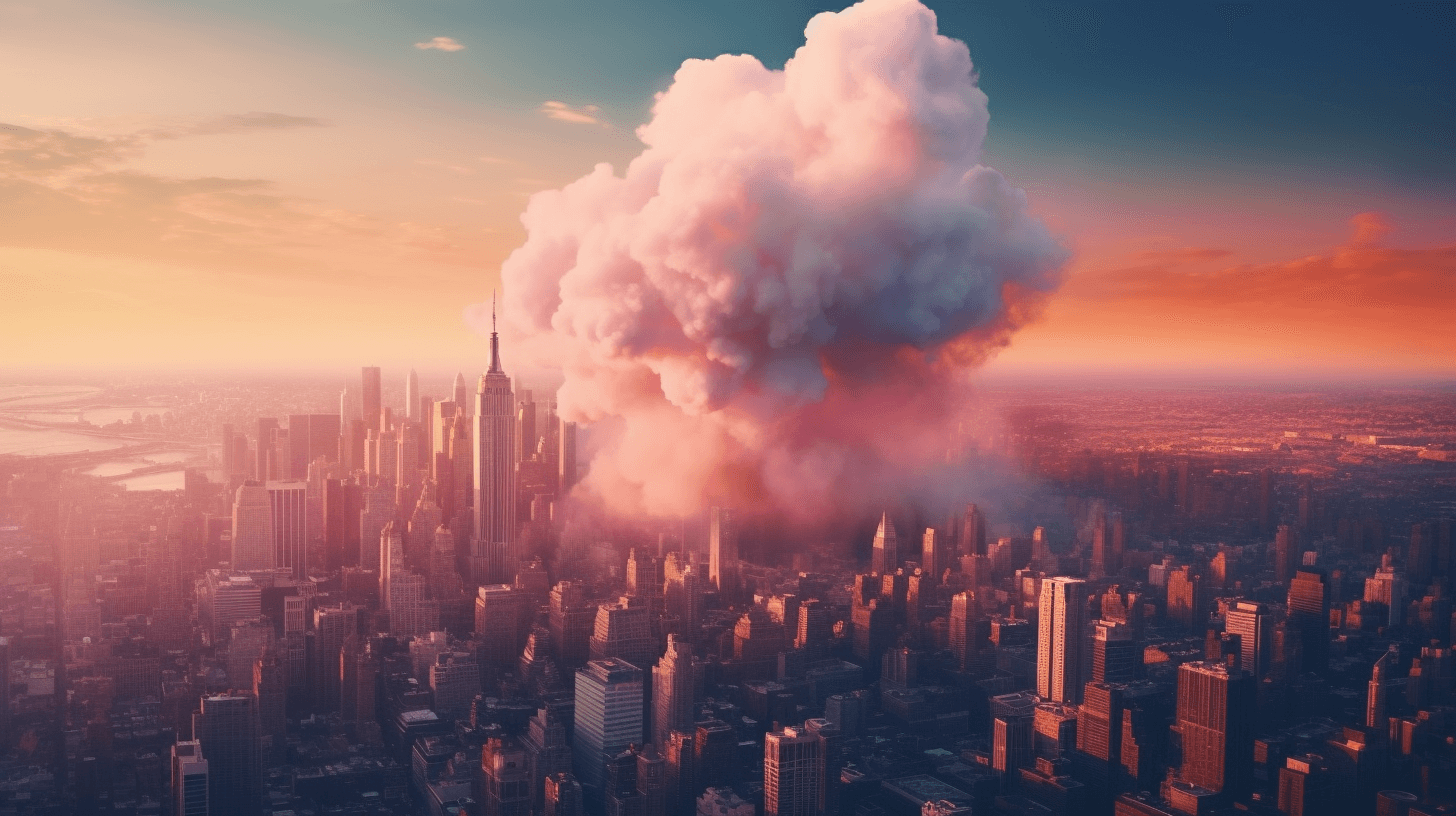🌬️🏢🦠 Huuuu, Da New War on Bad Air: Komo Covid-19 kam, oua buildings no moa fresh air!
Back in da days, if you had one building wit plenty fresh air, dass like one good medicine. But when Covid-19 show up, our buildings no moa space fo’ breathe. How dat happen? An’ how we goin’ bring back da fresh air? 🤔💭🏨
Dis here story go back to January 1912, when one special apartment complex open up in da Upper East Side of New York City. Dem called ’em East River Homes. Da purpose was fo’ help poor families fight against tuberculosis, dis airborne disease dat stay make everybody scared. Da plan? Turn dem dark, airless tenements inside out! 🏙️🌃🪟🌬️
Dis complex had passageways leadin’ from da street to big open courtyards inside. Den, dey had staircases goin’ up to each apartment. Da windows went all da way up to da ceilin’ an’ had balconies where sick people could sleep. On top of da buildings, da rooftops had porches an’ chairs fo’ people wit tuberculosis fo’ rest an’ recover. 🏨🛏️🌅💤
Da doctor who came up wit dis idea, Dr. Henry Shively, believed dat dese kinds of houses not only helped treat tuberculosis, but also stopped it from spreadin’. 🩺📜📚
Now, one of da big lessons we learn from da Covid-19 pandemic is dat fresh air stay important. Even dough da officials neva like fo’ admit dat da virus stay airborne at first, dey had to accept da truth dat da virus stay spreadin’ easy inside buildings. As da pandemic kept goin’, da experts started tellin’ people fo’ open up da windows an’ crank up da ventilation systems in buildings. Da message was clear: If you had one building wit good ventilation, you could fight off da disease. 🦠🪟🪟🪟💪
But dis idea no stay new. Over 100 years ago, when infectious diseases stay causin’ havoc in cities all ova da United States an’ Europe, da health experts knew dat fresh air stay powerful. Dey built open-air homes, hospitals, an’ schools in places like New York an’ London fo’ fight against da diseases. 🌍🏥🏫🌬️
But ova time, we wen fo’get about da importance of fresh air. We wen focus more on medicines an’ vaccines, tinkin’ dat we could solve da problem wit dem alone. We wen build big air-conditioned towers an’ seal our buildings tight, tryin’ fo’ save energy. By da time Covid-19 came, we stay spendin’ our days inside schools, offices, an’ homes dat barely get fresh air. Da virus dat stay spread indoors came face to face wit buildings dat neva designed fo’ keep people healthy. 💨🔒🏢
Joseph Allen, one expert on healthy buildings from da T.H. Chan School of Public Health at Harvard, say, “So you get one virus dat stay spreadin’ inside buildings, but our buildings neva stay designed fo’ protect our health.” 🏥🌬️🦠
Now, three years later, plenny people wen learn da importance of clean air da hard way. But some experts stay worried dat we goin’ forget da lesson. Da Covid-19 emergency stay pau, an’ now we stay focused on other problems like da smoky air from wildfires dat stay suffocatin’ Eastern cities. Some people might tink da best thing fo’ do is seal our buildings up tight again. But dat would be one big mistake, da experts say, especially when we know dat more pandemics an’ air-quality problems goin’ come in da future. If we like stay prepared, we gotta learn from our past mistakes. 🛡️🔒🦠💨🏢
Sara Jensen Carr, one architect from Northeastern University, say, “Da United States stay good at fo’gettin’ important things, yeah? I tink we stay close to fo’gettin’ how important fresh air stay.” 🇺🇸🤔💨
In da 19th century, wen had plenny dangerous infectious diseases goin’ ’round—like tuberculosis, cholera, smallpox, yellow fever, an’ typhoid. Da dirty, crowded cities wit deir smelly sewers an’ dirty drinkin’ water stay helpin’ da diseases spread. But da poor ventilation inside buildings stay one big problem too. 😷🏨💧💨
Da tenements in New York City stay real bad. Plenny rooms neva had windows, so no fresh air could come in. An’ some buildings stay so close together, even if you open one window, no breeze would come through. Da cellar apartments stay da worst. Dey say, “Da air stay foul, damp, like one place fo’ da dead instead of da livin’.” One report from 1853 say dat. 🏢🪟🤢🌬️
Back den, da people no stay believe in germ theory yet. Dey stay tinkin’ disease come from “bad air” (dass what “miasma” mean). So da health reformers start talkin’ ’bout how we gotta change da city an’ improve da ventilation fo’ fight against da diseases. Dey say, “Everywhere, we gotta have fresh air dat stay da right temperature. Dass da first ting we need fo’ be healthy.” 🌬️🌡️🌍🏨
New York City wen make plenny changes. Dey wen ban da underground apartments wit no air. Dey wen make one rule fo’ have windows dat open outside. An’ dey wen give more space between buildings. Da president of da American Society of Heating and Ventilating Engineers say in 1895, “Ventilation stay real important, yeah? It stay close to bein’ one gift from God.” 😇🔊🏙️💨
Hospitals wen make changes too, thanks to Florence Nightingale. Dis British nurse wen work in one dirty military hospital during da Crimean War in 1854. She stay believe dat “air from outside” stay good fo’ healin’. She wen help popularize da design of hospitals wit long, narrow wards dat get big windows on each side. Da whole building wen get built fo’ let fresh air move through. 💉🌬️🏥
Fresh air stay important fo’ treat tuberculosis too. Dey wen build special hospitals called sanitariums, an’ dey wen have schools outside where da students wen go class on top of roofs, army tents, an’ even on boats. 🌬️🏥🏫🛶
When da Spanish flu pandemic come in 1918, people wen expand dis idea. Some classrooms wen open deir windows, hospitals wen set up temporary outside areas, an’ da newspapers wen tell people fo’ use “winter window screens.” Even da churches wen get checked fo’ make sure dey had good ventilation. One report from da department of public health say, “Da pastors wen change deir sermons fo’ talk ’bout da epidemic an’ how fresh air an’ sunshine can heal.” 🌬️🪟🌤️🙏💒
We no can say fo’ sure if da better-ventilated buildings wen make one big difference. Da number of people dyin’, especially from tuberculosis, wen go down afta New York wen make da reforms. But we no can say it was all ’cause of da ventilation. Ova da years, though, plenny studies wen show dat if we improve da ventilation an’ open da doors an’ windows, we can reduce da risk of spreadin’ infectious diseases like tuberculosis an’ influenza. Recently, one study wen show dat wen dey increase da ventilation in one chamber wit patients dat had Covid-19, da amount of virus in da air went down. 😷🏨🌬️🦠
But as time went on, people wen start focusin’ more on comfort den health. Advances in medicine like antibiotics an’ vaccines wen help control diseases. People wen start using air conditionin’ more an’ tinkin’ outdoor air stay dirty. Dey wen say, “We no want da air from outside unless we filter ’em.” Da ventilation standards wen change too. Dey wen make da rates go down, an’ durin’ da energy crisis in da 1970s, buildings wen get sealed up even tighter. “Before Covid,” one architectural engineer say, “we stay tryin’ fo’ reduce da ventilation ’cause people no like spend too much energy.” ❄️❌🌬️💡💧
In da United States today, we get standards fo’ indoor air quality from da American Society of Heating, Refrigerating, an’ Air-Conditioning Engineers (ASHRAE). Dey stay set da rules fo’ minimum ventilation rates. But most buildings no give da amount of fresh air dey suppose to. Da standards say da air gotta be “safe” an’ make 80% of da people happy. But dey no talk ’bout infectious diseases. Da chairman of da epidemic task force at ASHRAE say dey stay changin’ dat now. Dey tryin’ fo’ make new standards fo’ fight against airborne diseases in new an’ old buildings. Dey talk ’bout da rate of air exchange, an’ dey say filters an’ air cleaners can help remove particles from da air. Da Centers for Disease Control an’ Prevention also get updated guidelines fo’ ventilation, filters, an’ air cleaners. 🌬️🔧🏨🦠
But da new recommendations no goin’ make one big difference unless we get some kind of incentive or enforcement, say da chairman. Right now, no government get involved wit indoor air quality. He say, “One government group gotta step up an’ take responsibility.” 🏢👮💪💨
We get one chance fo’ fight against bad air, yeah? Da experts say we can use tools an’ technologies dat da health reformers from da 19th century neva had. But da main thing we need fo’ remember, da spirit dat gotta drive us, stay dis: “Our buildings gotta help us stay healthy,” say Dr. Allen from Harvard. 🏢💪💨
So let’s open dem windows an’ doors, bring in da fresh air, an’ keep our buildings breathin’. Our health an’ da health of future generations stay dependin’ on it. 🌬️🏢🌍
NOW IN ENGLISH
🌬️🏢🦠 The New War on Bad Air: As Covid-19 arrived, our buildings lack fresh air!
Back in the days, having a building with plenty of fresh air was like having good medicine. But when Covid-19 emerged, our buildings no longer had space to breathe. How did that happen? And how can we bring back the fresh air? 🤔💭🏨
This story goes back to January 1912, when a special apartment complex opened in the Upper East Side of New York City. They were called East River Homes. The purpose was to help poor families fight against tuberculosis, an airborne disease that scared everyone. The plan? Turn those dark, airless tenements inside out! 🏙️🌃🪟🌬️
This complex had passageways leading from the street to big open courtyards inside. Then, they had staircases going up to each apartment. The windows went all the way up to the ceiling and had balconies where sick people could sleep. On top of the buildings, the rooftops had porches and chairs for people with tuberculosis to rest and recover. 🏨🛏️🌅💤
The doctor who came up with this idea, Dr. Henry Shively, believed that these kinds of houses not only helped treat tuberculosis but also stopped it from spreading. 🩺📜📚
Now, one of the big lessons we learned from the Covid-19 pandemic is that fresh air is important. Even though the officials didn’t want to admit at first that the virus is airborne, they had to accept the truth that the virus spreads easily inside buildings. As the pandemic continued, the experts started telling people to open up the windows and crank up the ventilation systems in buildings. The message was clear: If you had a building with good ventilation, you could fight off the disease. 🦠🪟🪟🪟💪
But this idea is not new. Over 100 years ago, when infectious diseases were causing havoc in cities all over the United States and Europe, health experts knew that fresh air is powerful. They built open-air homes, hospitals, and schools in places like New York and London to fight against the diseases. 🌍🏥🏫🌬️
But over time, we forgot about the importance of fresh air. We focused more on medicines and vaccines, thinking that we could solve the problem with them alone. We built big air-conditioned towers and sealed our buildings tight, trying to save energy. By the time Covid-19 came, we were spending our days inside schools, offices, and homes that barely got fresh air. The virus that spread indoors came face to face with buildings that were never designed to keep people healthy. 💨🔒🏢
Joseph Allen, an expert on healthy buildings from the T.H. Chan School of Public Health at Harvard, says, “So you have a virus that is spreading inside buildings, but our buildings were never designed to protect our health.” 🏥🌬️🦠
Now, three years later, many people have learned the importance of clean air the hard way. But some experts are worried that we will forget the lesson. The Covid-19 emergency is over, and now we are focused on other problems like the smoky air from wildfires that is suffocating Eastern cities. Some people might think the best thing to do is seal our buildings up tight again. But that would be a big mistake, the experts say, especially when we know that more pandemics and air-quality problems are going to come in the future. If we want to stay prepared, we have to learn from our past mistakes. 🛡️🔒🦠💨🏢
Sara Jensen Carr, an architect from Northeastern University, says, “The United States is good at forgetting important things, right? I think we are close to forgetting how important fresh air is.” 🇺🇸🤔💨
In the 19th century, we had many dangerous infectious diseases going around—like tuberculosis, cholera, smallpox, yellow fever, and typhoid. The dirty, crowded cities with their smelly sewers and dirty drinking water were helping the diseases spread. But the poor ventilation inside buildings was also a big problem. 😷🏨💧💨
The tenements in New York City were really bad. Many rooms didn’t have windows, so no fresh air could come in. And some buildings were so close together that even if you opened one window, no breeze would come through. The cellar apartments were the worst. They said, “The air is foul, damp, like a place for the dead instead of the living.” One report from 1853 said that. 🏢🪟🤢🌬️
Back then, people didn’t believe in the germ theory yet. They believed diseases came from “bad air” (that’s what “miasma” means). So the health reformers started talking about how we needed to change the city and improve the ventilation to fight against the diseases. They said, “Everywhere, we need to have fresh air that is the right temperature. That’s the first thing we need to be healthy.” 🌬️🌡️🌍🏨
New York City made many changes. They banned the underground apartments with no air. They made a rule to have windows that open outside. And they gave more space between buildings. The president of the American Society of Heating and Ventilating Engineers said in 1895, “Ventilation is really important, right? It is close to being a gift from God.” 😇🔊🏙️💨
Hospitals made changes too, thanks to Florence Nightingale. This British nurse worked in a dirty military hospital during the Crimean War in 1854. She believed that “air from outside” is good for healing. She helped popularize the design of hospitals with long, narrow wards that have big windows on each side. The whole building was built to let fresh air move through. 💉🌬️🏥
Fresh air is important for treating tuberculosis too. They built special hospitals called sanitariums, and they had schools outside where the students would go to class on top of roofs, army tents, and even on boats. 🌬️🏥🏫🛶
When the Spanish flu pandemic came in 1918, people expanded on this idea. Some classrooms opened their windows, hospitals set up temporary outside areas, and the newspapers told people to use “winter window screens.” Even the churches were checked to make sure they had good ventilation. One report from the department of public health said, “The pastors changed their sermons to talk about the epidemic and how fresh air and sunshine can heal.” 🌬️🪟🌤️🙏💒
We can’t say for sure if the better-ventilated buildings made a big difference. The number of people dying, especially from tuberculosis, went down after New York made the reforms. But we can’t say it was all because of the ventilation. Over the years, though, many studies have shown that if we improve the ventilation and open the doors and windows, we can reduce the risk of spreading infectious diseases like tuberculosis and influenza. Recently, one study showed that when they increased the ventilation in a chamber with patients that had Covid-19, the amount of virus in the air went down. 😷🏨🌬️🦠
But as time went on, people started focusing more on comfort than health. Advances in medicine like antibiotics and vaccines helped control diseases. People started using air conditioning more and thinking outdoor air is dirty. They said, “We don’t want the air from outside unless we filter it.” The ventilation standards also changed. They made the rates go down, and during the energy crisis in the 1970s, buildings got sealed up even tighter. “Before Covid,” one architectural engineer said, “we were trying to reduce the ventilation because people didn’t want to spend too much energy.” ❄️❌🌬️💡💧
In the United States today, we have standards for indoor air quality from the American Society of Heating, Refrigerating, and Air-Conditioning Engineers (ASHRAE). They have set the rules for minimum ventilation rates. But most buildings don’t provide the amount of fresh air they are supposed to. The standards say the air should be “safe” and make 80% of the people happy. But they don’t talk about infectious diseases. The chairman of the epidemic task force at ASHRAE says they are changing that now. They are trying to make new standards to fight against airborne diseases in new and old buildings. They talk about the rate of air exchange, and they say filters and air cleaners can help remove particles from the air. The Centers for Disease Control and Prevention also have updated guidelines for ventilation, filters, and air cleaners. 🌬️🔧🏨🦠
But the new recommendations won’t make a big difference unless we have some kind of incentive or enforcement, says the chairman. Right now, no government is involved with indoor air quality. He says, “A government group has to step up and take responsibility.” 🏢👮💪💨
We have a chance to fight against bad air, right? The experts say we can use tools and technologies that the health reformers from the 19th century never had. But the main thing we need to remember, the spirit that has to drive us, is this: “Our buildings have to help us stay healthy,” says Dr. Allen from Harvard. 🏢💪💨
So let’s open those windows and doors, bring in the fresh air, and keep our buildings breathing. Our health and the health of future generations depend on it. 🌬️🏢🌍







